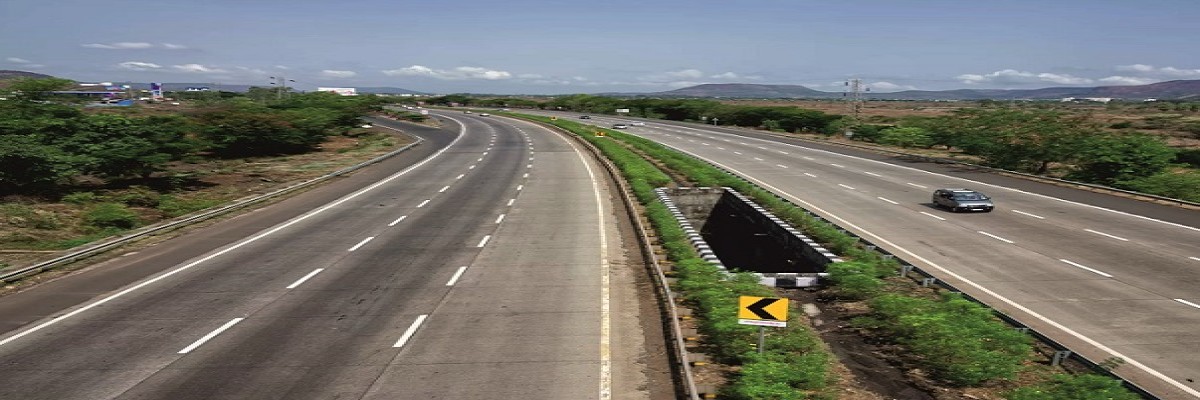Current Scenario of Road & Highways Development in India
For economic growth and development, adequate transportation infrastructure is a requirement. Rapidly developing nations like China and India face significant infrastructure issues. Although there is scant information on the economic effects of such programmes thus far, corporate leaders, legislators, and academics view infrastructure as a critical barrier to sustainable growth that necessitates support from the public. We explore how proximity to a significant new road network affects the organisation of industrial activity, particularly the placement of new plants, using industry-level sorting and resource allocation effectiveness. According to the most recent data from the ministry of road transport and roads, construction up to September of this year has only covered 3,559 km as opposed to a target of 12,000 km in FY23. This is less even than the 3,824 km built over the same time in pandemic-stricken FY22. Given that highway development in India only met a fourth of the yearly objective in the first half of the current fiscal year, signs of a slowdown in the sector appear to be growing stronger. According to the most recent data from the ministry of road transport and roads, construction up to September of this year has only covered 3,559 km as opposed to a target of 12,000 km in FY23. This is less even than the 3,824 km built over the same time in pandemic-stricken FY22. Not only is there a slowdown in construction, but it is also evident in the selection of new projects. In comparison to the 4,609 km of highways given between April and September of FY22, only 4,092 km of projects have been awarded in the first six months of the current year. In order to fill any gaps in construction this year, the government is relying on new road developments in Jammu and Kashmir, and Ladakh, which are already competitive in many locations. Additionally, it is planned to build about 500 km of highways in a matter of days. However, due to the fact that government agencies have never built more than 50 km of road every day, which is required to meet the 12,000 km target in time, analysts are sceptical that the construction will be finished. The last five years have seen a major expansion of the road transportation network. The Indian government has allocated more than Rs 1.18 lakh crore to the Ministry of Road Transport and Highways (MoRTH) for the fiscal years 2021–2022. The government has also chosen a number of trade routes that will aid India's economy in growing to USD 5 trillion by 2025. The fact that the industry makes up about 18% of the National Infrastructure Pipeline further demonstrates the sector's significance. Several state governments have also looked into the development of important road corridors as a catalyst for economic growth. A nation's complex, robust, and well-maintained road network over its length and breadth acts as a critical facilitator for its overall economic and social growth by enabling the efficient transit of both freight and passengers. The majority of travel in India is by road, which also helps other forms of transportation by providing and ensuring last-mile connections. India has the second-largest road network in the world, with 63.72 lakh km of roadways. Main district roads, lesser district roads, expressways, state highways (SHs), and village roads are some examples of these routes. National roads are the primary thoroughfares for interstate movement of people and goods in the country. There were 658 NHs in the country as of the end of January 2022, with a total length of 141,190 km. Despite comprising only 2.3% of the entire road system, it carries 40% of all traffic. By January 31, 2022, the length of the country's NHs had increased from 91,287 km in April 2014 to 141,190 km, a remarkable growth of 50% in just eight years. Be aware that between 2014 and 2015, 49,339 km of state roads received national highway status. The Indian government established the National Highways Development Project (NHDP), which comprised important steps to upgrade and reinforce NHs. The longest continuous asphalt/bituminous concrete road was built in India, according to Nitin Gadkari, Union Minister for Road Transport and Highways, who made the announcement earlier in June. In Maharashtra, NH-53 was constructed with a single lane of bitumen road between Amravati and Akola. The 75-kilometer road's construction took a recordbreaking 105 hours and 33 minutes. At 5:00 p.m. on June 7, the construction project was completed. following the start on June 3 at 7:27 a.m. In order to ensure that there is vegetation next to the highways, Nitin Gadkari stated that the National Roadways Authority of India (NHAI) would make its tree bank available. The Union minister emphasized the value of planting by the side of the road. Gadkari, the minister of roads and transportation, believes that for every tree that is removed, five more should be planted. Concerns over India's subpar track record in terms of road safety have prompted the government to seek for improved NH quality. The majority of traffic fatalities worldwide occur in this nation. While breaking traffic laws and driving recklessly are some of the major causes of accidents, poor road conditions and shoddy road construction have also been given the blame.
Highway Expansion - A Growth Driver
Highways link people, products, and raw materials, which is essential to a nation's ability to function. India is gradually on pace to achieve standards on par with the finest in the world because to the fast growth and modernization of its road network. India has been actively constructing a reliable network of roads, motorways, and expressways as part of the "Bharatmala" initiative of the national government. Additionally, India wants to construct at least 26 green expressways by 2025. The road and highway infrastructure in India accounts for over 60% of all cargo movement. The growing network of motorways and expressways is intended to be the driving force behind the transformation and aid in bringing down logistics costs from their present range of 16–18% of GDP to 10%. Recently, Nitin Gadkari, the union's minister for roads and highways, claimed, "We can cut the cost of logistics by 10% to 12% in India. We will be more competitive in the global market because to the 4–6% savings. By doing so, we can raise our growth rate while simultaneously increasing exports and maybe lowering costs ". According to current predictions, the highway building sector will see a phenomenal rise of 133% by 2025, which will be higher than in any other nation in recent memory. Even India's neglected and dangerous northern and northeastern regions are now connected to the country's burgeoning road and highway network. In order to improve the nation's military capabilities, the Border Road Organization has been working nonstop to construct roads along the Indian border. For quick logistical support in the face of an ambitious and expansionist China, building road infrastructure is crucial. According to the administration, in the upcoming years, the nation will have one of the greatest road network in the world, which will not only be important to its economy but also serve as an example for other nations.
Industry Scenario of Road & Highways
In India, the market for roads and highways is anticipated to increase at a CAGR of 36.16% by 2025 as a result of expanding government initiatives to upgrade the nation's transportation infrastructure. The CAGR over the years 2016–17 to 2021–22 is 20%. India's roads industry has always been a leader in terms of effectiveness and innovation. Based on the Hybrid Annuity Model, the government of India has successfully implemented over 60 road projects valued over $10 billion (HAM). HAM has increased PPP activity in the industry and effectively balanced risk among private and governmental partners. The National Highways Authority of India (NHAI) has adopted asset recycling using the toll-operatetransfer (ToT) model for 100 highways. For an investment of almost $2 billion, the first two bundles of nine motorways each were successfully monetized. The NHAI has gone "Fully Digital" with the introduction of a special cloud-based and Artificial Intelligence-powered Big Data Analytics platform - Data Lake and Project Management Software - as one of the major changes in the Indian road transportation sector. The whole project management process at NHAI is now online portal based rather than manual, and all project execution procedures, such as "workflow with time lines" and "alarm mechanisms," have been set up. Now, the site is used for all project paperwork, contractual decisions, and approvals.
Latest Announcements
• The central government has sanctioned projects for the state of Maharashtra alone totaling Rs 50,000 crore for better road infrastructure and Rs 75,000 crore for the railways. When the government invests such a significant sum in infrastructure projects, thousands of new employment are also created. Numerous job prospects will be made available to Maharashtrians in the future.
• At a ceremony held on October 28 along the Durbuk-Shyok-Daulat Beg Oldie route (DS-DBO) road in Ladakh, Defense Minister Rajnath Singh dedicated 75 infrastructure projects constructed by the Border Roads Organisation (BRO). The Chinese PLA's opposition to the vital road that provided easy access for the Indian forces was one among the factors that led to the military stalemate between India and China in Ladakh in 2020. This was because India was building a road on the Durbuk-ShyokDaulat Beg Oldie route (DS-DBO).
• The proposed greenfield Bengaluru-Pune Expressway is the subject of a detailed project report (DPR) by the Union Ministry of Road Transport and Highways (MoRTH). The proposed expressway, estimated to cost Rs 50,000 crore, will start at Kanjale on the currently under construction ring road in Pune, end at Muthugadhalli in the Doddaballapur taluk of Karnataka, and connect to Bengaluru via the Satellite Ring Road. It is part of Phase 2 of the Prime Minister's flagship Bharatmala scheme. The highway would also join the Pune-Mumbai expressway in Pune. The six-lane highway will be constructed to accommodate 120 km/hr vehicle speeds. Once finished, it will guarantee that the present 13 to 14-hour travel time between two cities will be down to 6 hours. A 700 km section of the greenfield expressway is being considered. The current length of the national highway between Bengaluru and Pune is around 750 km, while the total distance between the two cities is about 850 km. The proposed expressway's route will pass through a total of three Maharashtra districts—Pune, Satara,and Sangli—and nine Karnataka districts—Belagavi, Bagalkot, Gadag, Koppal, Vijayanagara, Davanagere, Chitradurga, Tumakuru, and Bengaluru Rural.
• The Narendra Modi administration has suggested building six additional roads in Arunachal Pradesh totaling 2,178 kilometres in length as part of ongoing efforts to increase connectivity along the border with China.
• According to Union Road Transport and Roads Minister Nitin Gadkari, the Ministry of Road Transports and Highways (MoRTH) intends to take over the State Highways with high traffic density from the State Governments for a 25-year period and transform them into 4 or 6 lane highways.
• Nitin Gadkari, the Union Minister for Road Transport and Highways, announced that the nation would soon have 27 green express highways. By the end of this year, highways will connect Delhi with Dehradun in two hours, Delhi with Hardwar in two hours, Delhi with Jaipur in two hours, Chandigarh in two hours, Amritsar in four hours, Srinagar in eight hours, Delhi with Katra in six hours, Delhi with Mumbai in ten hours, Chennai with Bengaluru in two hours, and Lucknow with Kanpur in thirty minutes.
• According to the Minister, the Ministry is also building 75 tunnels at a cost of 2,50,000 crores. In the nation, 40 km of new roads are built per day on average. Currently, the country's roads total 65 lakh kilometres, of which 1.45 lakh kilometres are National Highways.
Conclusion
India is utilising cutting-edge technologies to rapidly and sustainably complete the most difficult road projects, with the added benefit of lowering project lifetime costs. There are, however, geological issues with tunnelling. The risk matrix has to account for unforeseen events. The provisions of tunnel contracts have mostly been modified from highway contracts in recent years. The primary attention has been placed on road safety. Several steps have been done in this direction, such as the elimination of "black spots," the development of driver-training facilities, the introduction of the SukhadYatra app and toll-free emergency number, the expansion of police capability, etc. Concessionaires, consultants, and other contractors that work on the NHAI field team have all received training. A road safety study must be conducted by independent safety specialists.
















Leave a comment